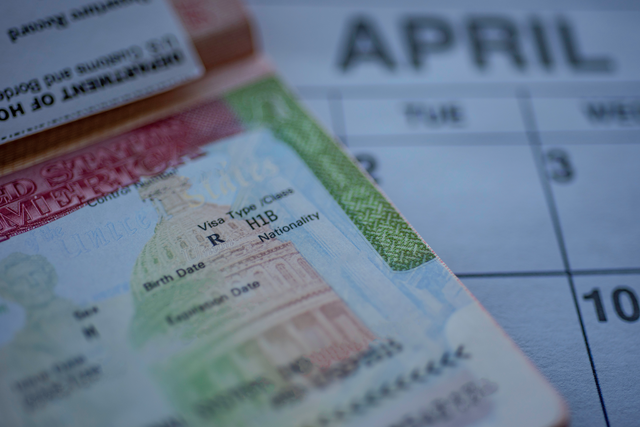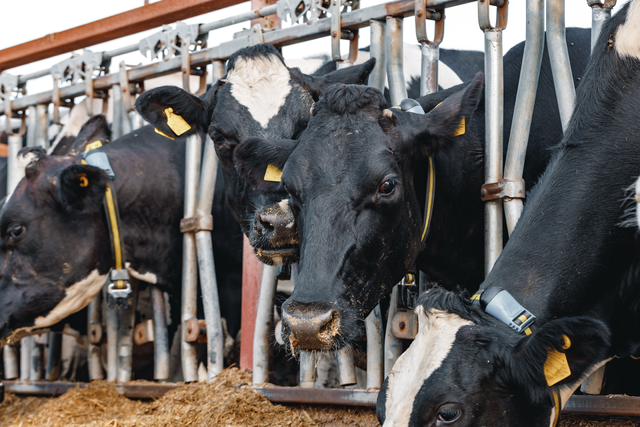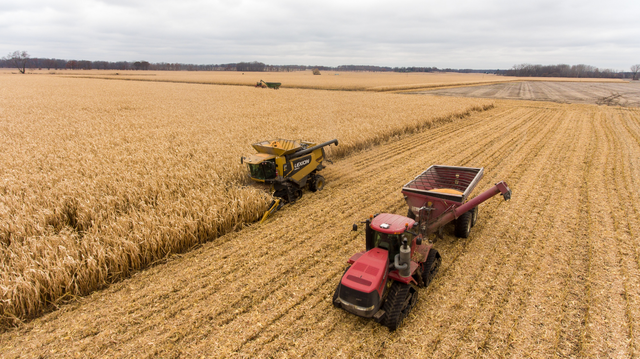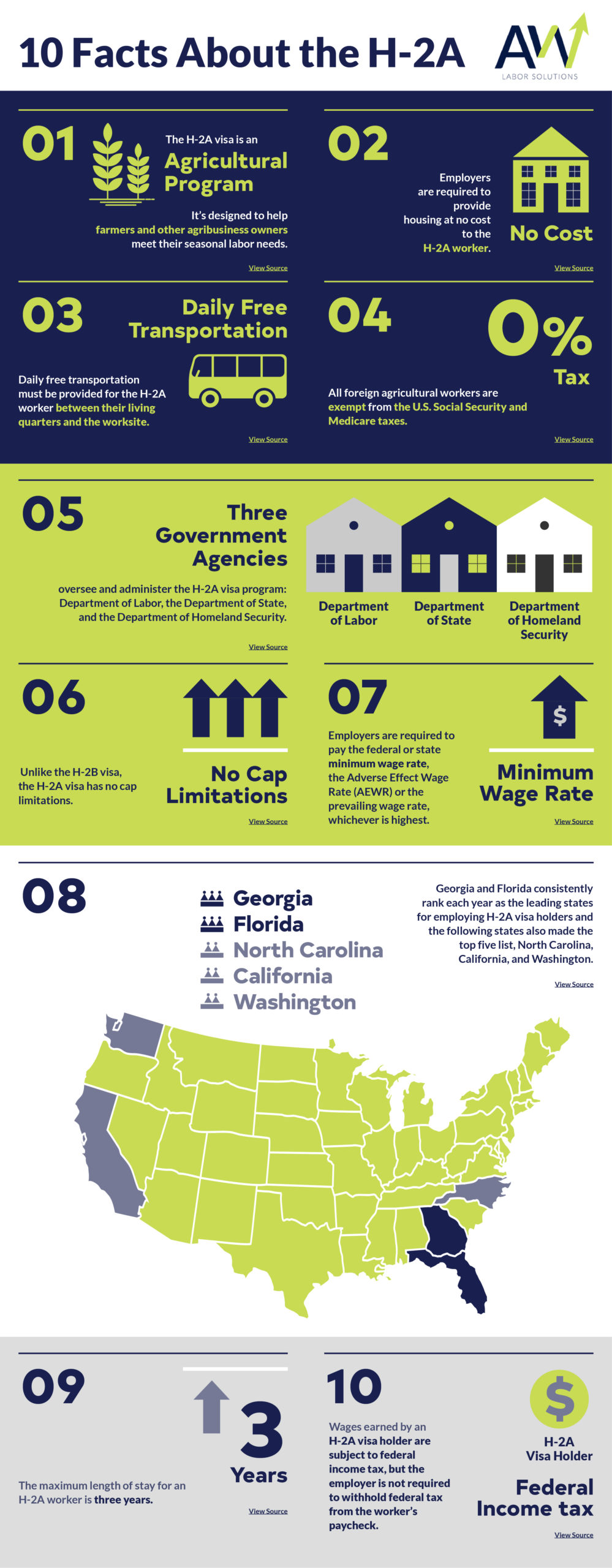The H-2A program allows American employers to legally hire foreign temporary workers if such employers are unable to fill their agricultural labor needs with regional U.S. laborers.
In this handy guide, we will explore the H-2A employer requirements, so you know exactly how you can participate in the beneficial program. We also encourage you to look over the regulations outlined in the Department of Labor 20 CFR 655 Subpart B and 29 CFR 501.

What is the H-2A Visa Program?
The H-2A visa program was implemented by the Immigration and Nationality Act (INA), to meet the needs of American agricultural employers who cannot fill critical seasonal labor positions with U.S. workers. Under the program, U.S. employers can hire foreign workers to temporarily perform agricultural work.
The Department’s OFLC located within the Employment and Training Administration, handles all receiving and processing of employer-filed H-2A visa applications. The department processes each H-2A application while considering whether there are enough qualified U.S. workers available to meet U.S. labor needs; the department also examines the potential impact of hiring foreign workers on local U.S. worker wages and/or working conditions.

The Department’s Wage and Hour Division is tasked with overseeing the terms and conditions of all agricultural work contracts, while ensuring that worker protections are in place, which are outlined under the H-2A Program.
In 1986, the U.S. Congress drafted the H-2A visa program. The purpose of the H-2A visa was to legally allow foreign workers to temporarily work for U.S. Farmers who were unable to hire American workers to fill their labor needs.
Sadly, during the 1990s, illegal workers dominated the agricultural industry and the H-2A program was hardly ever used. Today, the H-2A visa program supplies 10 percent of the nation’s farm labor. Many believe that the expansion of the H-2A visa program contributed to the decline of illegal immigration from Mexico.

H-2A Employer Requirements
Any U.S. employer or group of agricultural producers who need temporary or seasonal agricultural workers can use the H-2A program to hire foreign workers. Each employer must apply with the OFLC for an H-2A labor certificate.
The H-2A employer requirements are as follows:

H-2A Visa Application Paths
There are four paths available to potential agricultural employers seeking to employ H-2A workers.
Standard Path
The processing time to hire H-2A workers under a standard path takes approximately 75 days. Requirements for employers are as follows:
Emergency Path
Employers can opt for an emergency pathway to obtain H-2A workers if there is a desperate need for laborers in less than 75 days.
The difference between a standard and an emergency path is that under an emergency path, employers simultaneously submit the job order to the State Workforce Agency and the temporary labor certification to the Department of Labor’s Chicago National Processing Center. Employers will then follow the rest of the standard filing steps. Submitting both forms simultaneously will save employers valuable time.
Immediate Path
The immediate path applies if an employer needs workers in 44 days or less. Under this path, employers must email tlc.chicago@dol.gov (the Department of Labor’s Chicago National Processing Center) to verify that there is enough time to complete the process. In the email’s subject line, employers should type: “H-2A Program Question: Immediate Need for H-2A Workers.” Justification for the emergency need must also be presented.
Extension Path
You have options when it comes to extending your current H-2A visa contract. If you need a short-term extension of only two weeks or less, then you can submit a Petition for Nonimmigrant Worker to the US Citizenship and Immigration Services.
If you need to extend your worker’s visa for a period longer than two weeks, then you should send a Petition for Nonimmigrant Worker to the U.S. Citizenship and Immigration Services, along with a notice to the US Department of Labor’s Chicago National Processing Center to further explain why you are requesting an extension.

H-2A Employer Process
Obtaining a temporary labor certification from the OFLC under the H‐2A program is straightforward. The steps of obtaining an H-2A employer petition are as follows:
Fill out and submit an agricultural job order with the State Workforce Agency (SWA) within the state where you wish the work performed. The job order should contain:
Furthermore, you will complete the following:
You will need to submit more than one state agricultural job order with all local SWAs if the job is to be performed in more than one state. The SWA will inspect the job order and advise you only if there are needed corrections. If everything looks good, then the agency will initiate the recruitment of workers. The review usually takes seven days. If there are any problems or corrections needed, then changes must be submitted generally within five days. The SWA will then issue a final decision within three days.
Upon acceptance, the SWA will start taking applications from U.S. workers. You must cooperate with SWA to see if you can hire American workers to fill the job openings in place of foreign workers.
The Chicago National Processing Center (CNPC) receives and processes all employer-filed H-2A paperwork. The CNPC is your final point-of-contact for the last leg of the labor certification process. It’s important to note that you will not be able to file an I‐129 visa petition for H‐2A workers with USCIS until the CNPC grants a temporary labor certification. The CNPC will review your application and let you know if there are any problems or questions. You will need to take care of this step at least 45 days before the start date of the job you are trying to fill.
File the following documents with the CNPC
The application package must be received no later than 45 days before the job’s start date, and sent to the following address:
U.S. Department of Labor Office of Foreign Labor Certification
Chicago National Processing Center
Attention H-2A Program
11 West Quincy Court
Chicago, Il, 60604-2105
Emergency Filing Request Requirements
Employers can also submit their application electronically.
In some situations, an employer can file an emergency filing request in less than 45 days if they (1) are a first time applicant, (2) have experienced an immediate and unforeseen need for laborers, and (3) SWA failed to respond in a timely manner.
After Filing: What Happens?
The CNPC will review an employer’s H-2A application and paperwork, and notify employers within 7 days. If you filed via email, then CNPC will notify you via the email used at the time of filing. If you did not use an email, then a final determination will be sent to you via a next day delivery service.
What Happens When a Deficiency Occurs?
If you fail to complete the entire application, or fail to disclose proper wage information, benefits, or answer all questions about working conditions, then you will receive a Notice of Deficiency (NOD). The NOD states the reasons your application was unacceptable and the steps needed to correct each spotted issue. And generally, employers have five days to respond once a NOD is received. If an employer submits an NOD response, but the certifying officer deems the response inadequate and issues a denial, then the employer can submit an appeal to the Department’s Administrative Law Judge (ALJ). Appeals must be filed within five business days after receiving the deficiency notice.
If you fail to send your response requesting a review within 12 days to the CNPC, then CNPC will consider your application abandoned and deny you the labor certification. You have only five business days to request a hearing.
Once you receive your Notice of Acceptance,it is time to advertise and actively try to recruit U.S. workers to fill your job needs. Outlined on the Notice of Acceptance are detailed information on where and how to advertise for workers. You will need to show details such as when and where you advertised for U.S. workers, and what the advertisement stated. You will also need to prepare a recruitment report outlining your process to find eligible U.S. workers. Please remember, this is a critical step in the process and should not be taken lightly. The CNPC will examine your efforts to decide whether to issue you a temporary labor certification.
You must actively advertise and recruit from the time you receive your Notice of Acceptance until the date that your H-2A workers depart for your jobsite (or the third day before your job is set to start).
Process of recruitment
Advertisements seeking U.S. workers must contain:
Job Interview Requirements
If you require interviews, then you must conduct the interview via phone or provide an alternative location where the worker is interviewed at no cost to the worker.
Preparing the Recruitment Report
While undergoing the recruitment process, the SWA may refer U.S. workers to you for consideration and send self-referrals. You will need to prepare a recruitment report and provide specific dates to submit to the CNPC.
A recruitment report will contain the following:
You will need to continue your recruitment efforts and regularly update your report through 50 percent of the work contract.
The final recruitment report is for your own records. You do not need to submit it to the CNPC unless you are audited, or the department requests the report.
The CNPC will weigh all information to determine whether there is an insufficient number of U.S. workers to meet your employment needs. CNPC must also determine that your employment of H-2A workers will not adversely impact the working environment or wages of U.S. workers.
Final documents to be submitted include:
What Happens if You Receive a Denial?
If, after review, the CNPC decides that your H-2A application does not meet the required criteria, a denial will be issued. The Final Determination letter will outline the reasons for your denial, and give you seven days to request a hearing. If you are denied, you must still retain all the paperwork for at least three years from the date of the denial for your own records.
Receiving a Determination
If you have successfully followed all steps and provided all the necessary documentation, then you will obtain a temporary labor certification. A final determination letter (ETA Form 9142 and Appendix A.2) and an invoice requesting payment for all fees such as the processing fee ($100) and a fee for each number of workers certified ($10 per worker) will all be included in your invoice. Failure to pay necessary fees within 30 days could cause sanctions.
Types of Determination Letters
The CNPC may issue one of the following:
After being granted the labor certification, you can gather your certified ETA Form 9142 and Appendix A.2 to the USCIS. You must submit Form I-129 Petition for Nonimmigrant Worker to the USCIS.
FAQ About H-2A Visa
Below are a few common questions about the H-2A Visa:
Who Qualifies for an H-2A Visa?
How Much Does It Cost an Employer to Sponsor an H-2A Visa?
An H-2A visa holder can bring their spouse and any unmarried children under 21 years old. An H-2A worker can also opt to have their family join them later using an H-4 status. However, it should be noted that H-4 visas are not automatically granted. The H-2A workers must apply for each family member and supply supporting documents such as marriage certificate and birth certificates.
How Long Does It Take to Process an H-2A Visa?
It usually takes two to four months to fully process an H-2A visa. In some cases, it might take longer.
What is the Difference Between an H-2A Visa and an H-2B Visa?
The H-2A visa is issued for seasonal or temporary agricultural workers.
An H-2B visa is issued for non-agricultural skilled or unskilled workers, if there is a shortage of U.S. workers.
Can an H-2A Visa Lead to U.S. Citizenship?
No, an H-2A visa is for seasonal or temporary agricultural workers. It is considered a nonimmigrant visa with no pathway towards citizenship.
How Long Can Someone Stay on an H-2A Visa?
A person can stay for three years on an H-2A visa. However, if the person has held an H-2A visa for three years, then such person must leave the United States and stay outside the country for at least three months before trying to reenter the U.S. with an H-2A visa. The visa must be extended in one-year increment for work.
Do H-2A Workers Pay U.S. Federal Income Tax?
Yes, they pay U.S. federal income tax. However, they do not pay U.S. social security or Medicare taxes.
Is There a Cap for H-2A Workers?
No, there is no cap for H-2A workers, unlike H-2B workers which have an annual cap of 66,000 workers.
Who Qualifies for H-2A Workers?
To qualify to employ H-2A workers, you must have an agricultural job that is temporary or seasonal. You must also show that there are not enough U.S. workers to fill your need in your geographic location.
Is There a Maximum Age for an H-2A Worker?
No, there is no maximum age for an H-2A worker, however, there is a minimum age of 18 years.
Why do Agricultural Employers Use the H-2A Visa Program?
Typically, employers who use the H-2A visa program to hire workers are in the crop industry. Crops are seasonal and during the planting and harvesting seasons, many farmers require assistance. In contrast, dairy and livestock employers rarely have seasonal positions and, instead, hire full time workers.
Why Do Workers Apply for H-2A Visas?
Workers apply for H-2A visas for a variety of reasons. For example, some unskilled workers may face job shortages in their home country, so applying for an H-2A visa represents lucrative employment opportunities. Also, the H-2A visa has very few restrictions, which increases the chances of a visa approval.
What Countries Can Participate in the H-2A Visa Program?
Typically, many think that the H-2A program is for Mexican workers only. However, the H-2A visa program is open to citizens in over eighty countries. In January 2021, the Department of Homeland Security (DHS) released the following list of countries whose citizens are eligible for an H-2A visa.
The DHS removed the State of Samoa and Tonga due to their inability to meet the necessary regulations.
